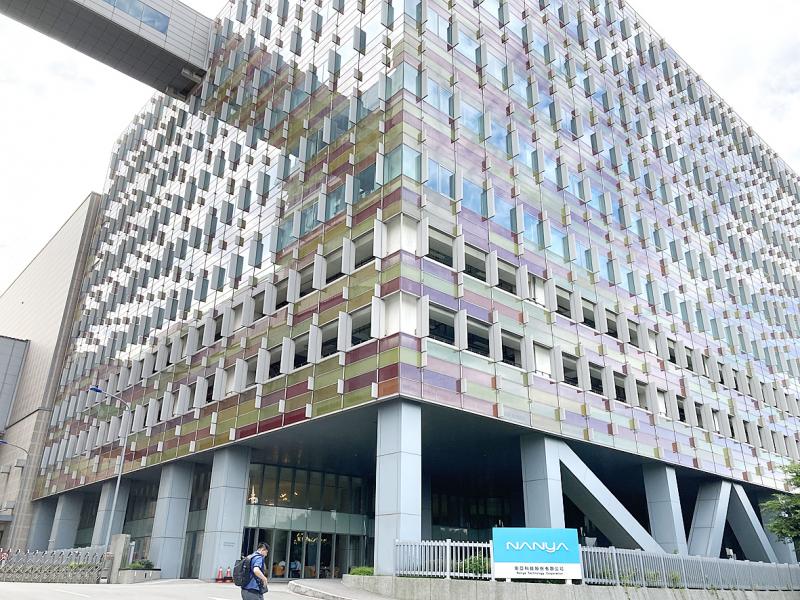Chipmaker Nanya Technology Corp (南亞科技) yesterday said that its net profit surged to the highest level in five quarters last quarter, as work-from-home and remote learning helped buoy demand for DRAM chips used in PCs and servers.
Amid the COVID-19 pandemic, the company’s growth momentum is expected to extend into this quarter, it said.
Combined with a seasonal uptick in demand for smartphones, TVs and game consoles, DRAM prices and shipments are forecast to at least remain flat this quarter, compared with last quarter, it added.

Photo: Lisa Wang, Taipei Times
“We have seen demand for smartphones and certain consumer electronics show clear seasonal effects in the third quarter,” Nanya Technology president Lee Pei-ing (李培瑛) told a media briefing in New Taipei City.
In addition, the uptake of 5G applications would continue to fuel demand for networking devices in the second half of the year, Lee said.
While the world’s top three memorychip companies, led by Samsung Electronics Co, have healthy inventories, the pandemic could curtail market demand, as the US, India and other nations are still trying to rein in the spread of COVID-19, he said.
That there are fewer advertisements on Facebook and Google is reducing demand for servers and data centers, and therefore DRAM chips, he added.
The unresolved US-China trade dispute is also dampening demand from certain clients, Lee said.
Nanya has not experienced a direct impact from the US restrictions on exports of technologies developed by US firms to Huawei Technologies Co (華為), he said, adding that the firm is supplying Huawei with memory chips that it designed.
“I am cautiously optimistic about the market outlook in the second half,” Lee said.
The company posted net profit of NT$3.21 billion (US$108.40 million) last quarter, up 66.5 percent from NT$1.93 billion in the first quarter, and a 17 percent increase from NT$2.75 billion in the same period last year.
Earnings per share rose to NT$1.05 last quarter, from NT$0.63 in the previous quarter and NT$0.9 last year.
Gross margin rebounded to 30.6 percent last quarter from 23.8 percent in the first quarter, ending three quarters of decline, which the company attributed to higher chip prices and shipments.
Gross margin was 34.9 percent in the same period last year.
DRAM chips used in PCs and servers generated NT$16.49 billion of revenue last quarter, accounting for 25 percent of total revenue, up from 20 percent in the first quarter.
Nanya said that it is aiming to increase the revenue contribution from DRAM chips used in servers to more than 10 percent by the end of this year, compared with 5 to 7 percent last quarter.
Nanya is planning to almost triple its capital spending to NT$15.76 billion this year, up from NT$5.5 billion last year.

TECH BOOST: New TSMC wafer fabs in Arizona are to dramatically improve US advanced chip production, a report by market research firm TrendForce said With Taiwan Semiconductor Manufacturing Co (TSMC, 台積電) pouring large funds into Arizona, the US is expected to see an improvement in its status to become the second-largest maker of advanced semiconductors in 2027, Taipei-based market researcher TrendForce Corp (集邦科技) said in a report last week. TrendForce estimates the US would account for a 21 percent share in the global advanced integrated circuit (IC) production market by 2027, sharply up from the current 9 percent, as TSMC is investing US$65 billion to build three wafer fabs in Arizona, the report said. TrendForce defined the advanced chipmaking processes as the 7-nanometer process or more

China’s Huawei Technologies Co (華為) plans to start mass-producing its most advanced artificial intelligence (AI) chip in the first quarter of next year, even as it struggles to make enough chips due to US restrictions, two people familiar with the matter said. The telecoms conglomerate has sent samples of the Ascend 910C — its newest chip, meant to rival those made by US chipmaker Nvidia Corp — to some technology firms and started taking orders, the sources told Reuters. The 910C is being made by top Chinese contract chipmaker Semiconductor Manufacturing International Corp (SMIC, 中芯) on its N+2 process, but a lack

Who would not want a social media audience that grows without new content? During the three years she paused production of her short do-it-yourself (DIY) farmer’s lifestyle videos, Chinese vlogger Li Ziqi (李子柒), 34, has seen her YouTube subscribers increase to 20.2 million from about 14 million. While YouTube is banned in China, her fan base there — although not the size of YouTube’s MrBeast, who has 330 million subscribers — is close to 100 million across the country’s social media platforms Douyin (抖音), Sina Weibo (新浪微博) and Xiaohongshu (小紅書). When Li finally released new videos last week — ending what has

OPEN SCIENCE: International collaboration on math and science will persevere even if the incoming Trump administration imposes strict controls, Nvidia’s CEO said Nvidia Corp CEO Jensen Huang (黃仁勳) said on Saturday that global cooperation in technology would continue even if the incoming US administration imposes stricter export controls on advanced computing products. US president-elect Donald Trump, in his first term in office, imposed restrictions on the sale of US technology to China citing national security — a policy continued under US President Joe Biden. The curbs forced Nvidia, the world’s leading maker of chips used for artificial intelligence (AI) applications, to change its product lineup in China. The US chipmaking giant last week reported record-high quarterly revenue on the back of strong AI chip